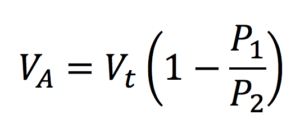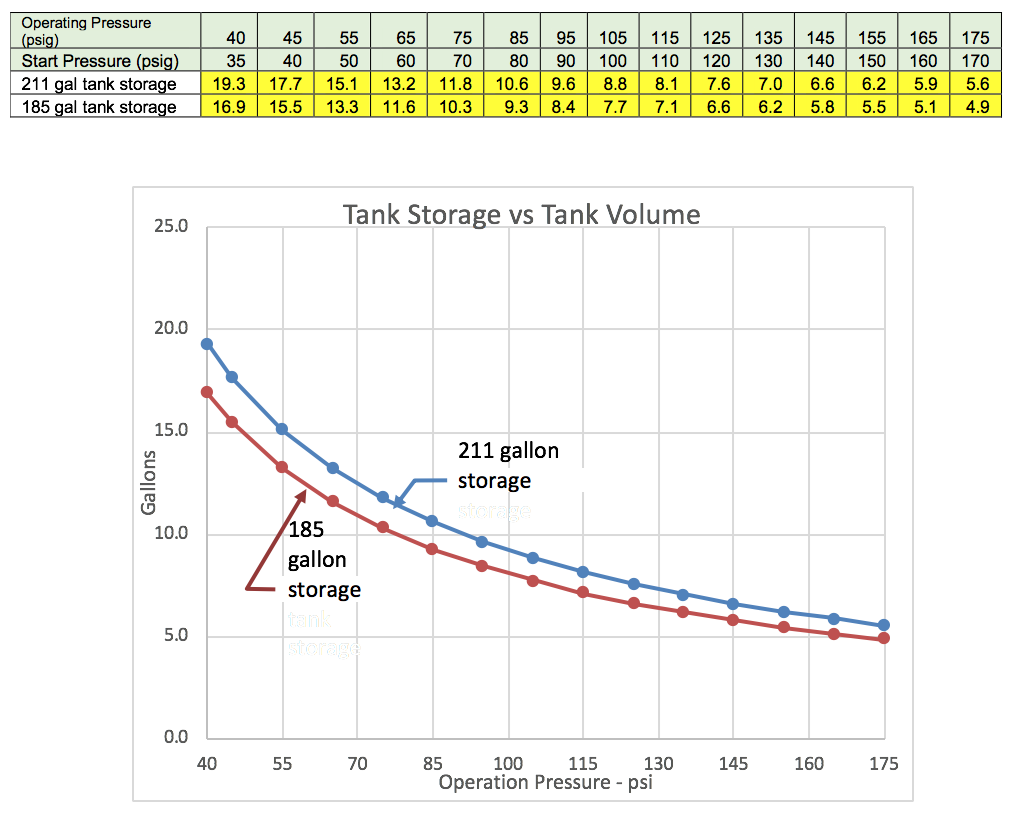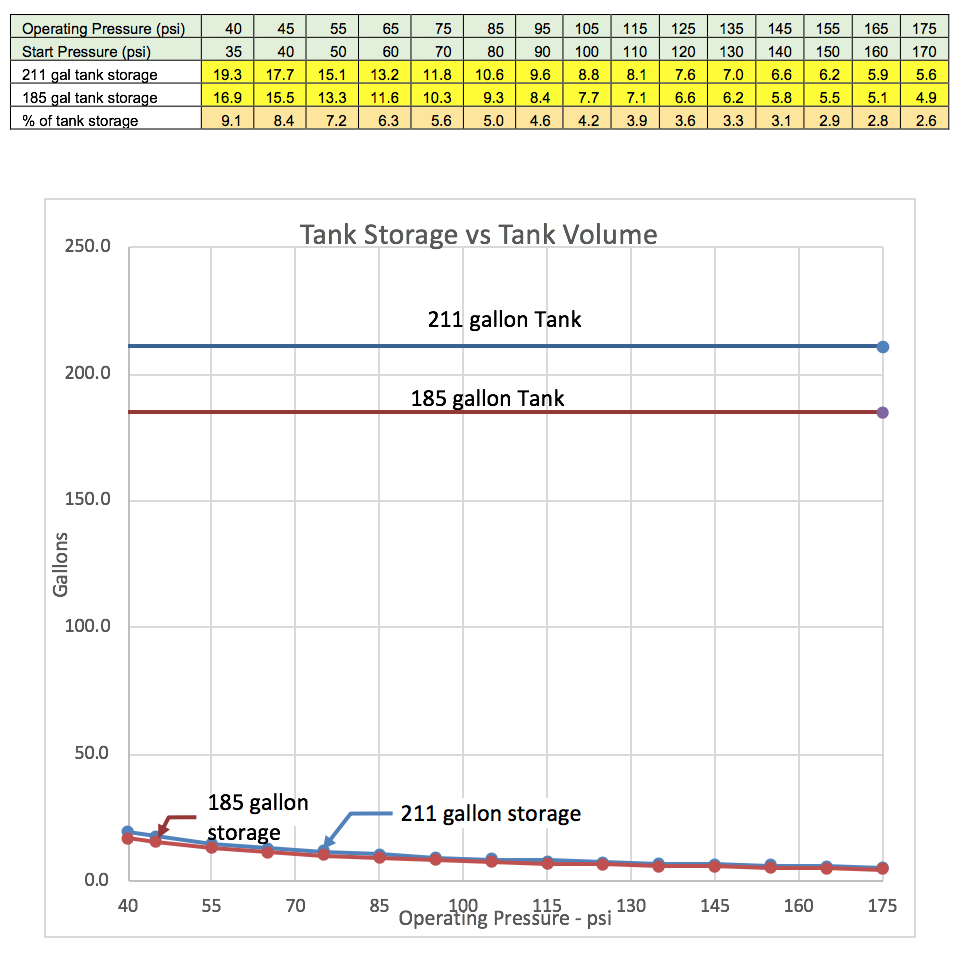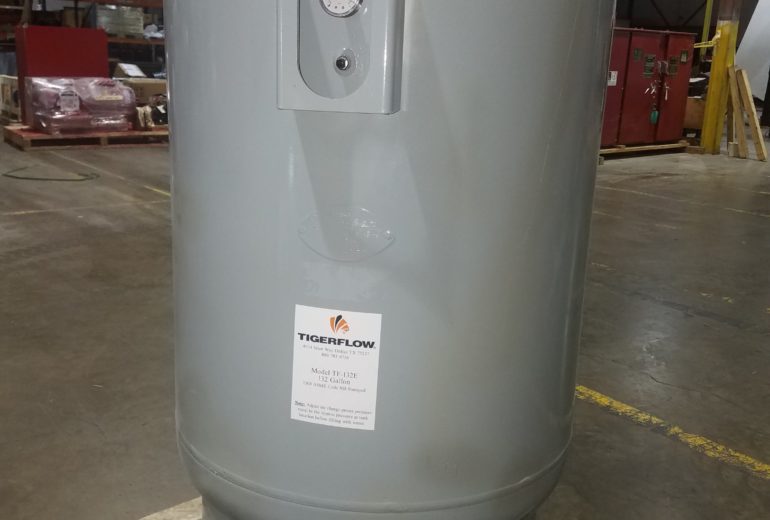When to Use an Expansion Tank
Expansion tanks are primarily used in water booster applications to keep the pump from starting excessively due to small piping leaks in a building (leak load). Excessive starting not only shortens the life of the controls and the pump’s motor, but it’s also costly in terms of energy use. Expansion tanks are sometimes required by variable speed drive (VFD) manufacturers to ensure smooth operation. We’ll examine tanks used for leak loads only, as tank sizing for VFD’s should follow the manufacturer’s recommendations. Expansion tanks should only be installed if the application is not in continuous use (hospitals, prisons, etc.)[1] or if it’s required by the VFD manufacturer.
Location, Location, Location
The approximate volume of water stored in a tank (VA) is calculated using the following formula:

Where VT = volume of the tank, P1 = tank pre-charge pressure and P2 = the pressure the tank is exposed to when the pump shuts off (absolute pressure[2]). What is important to note about the formula is that the volume of water stored is greatest when the P1/P2 ratio is the smallest. Let’s examine what effect the tank location has on this ratio.
* In our examples, we’ll assume that we are working close to sea level with an atmospheric pressure of 14.7 psia.
Tank located @ ground floor. A 100-gallon tank located at the base of the building with a P1 pre-charge of 50 psig (64.7 psia) and P2 shut-down of 60 psig (74.7 psia) will give us a ratio of 0.87 and a tank storage of 13.4 gallons.

Tank located @ top of the building. Placing the tank at the top of the building (4 stories in this example) allows us to drop the P1 pre-charge to 30 psig* (44.7 psia), and the P2 shut-down pressure the tank experiences is now 40 psig (54.7 psia). This results in a smaller ratio of 0.82 and a tank storage of 18.3 gallons.

This is a 37% increase in storage. A tank located at the highest level possible stores the most water.
*Please note that we dropped the pre-charge by 20 psi (≈46’ water column) because we moved the tank up 4 stories (~48’) and no longer have to overcome that static height.
[1] Expansion tanks used in continuous use applications will generally not store any water.
[2] Absolute Pressure (psia) = Gauge Pressure (psig) + Atmospheric Pressure (psia)
Pre-charging: The Great Debate
Depending on the source, the recommended pre-charge pressure of the tank can be lower or greater than the system set pressure to maximize the drawdown volume. However, there is a difference between the volume of water a tank can store and the maximum amount of usable water in such tank. Setting the correct pre-charge pressure on the tank will maximize the usable water stored.
Compare the pre-charge pressure to the pump start pressure setpoint (PStart) using the conditions from the second scenario described above.
Pre-charge equal pump start pressure setpoint.
P1 = 44.7 psia (30 psig)
P2 = 54.7 psia (40 psig)
PStart = 44.7 psia (30 psig)

Pre-charge 5 psi below pump start pressure.
P1 = 39.7 psia (25 psig)
P2 = 54.7 psia (40 psig)
PStart = 44.7 psia (30 psig)
![]()
However, the pump will start at 30 psig (44.7 psia) before all the water stored in the tank is used. The volume of water that remained in the tank must be taken into account when calculating the volume of usable water (VU). Remember, the purpose of the tank is to minimize the number of starts a motor undergoes by maximizing the amount of water used from the tank.
If we subtract the unused water from the total stored water, we show only 16.2 gallons of useable water.

Or

Pre-charge 5 psi higher than pump start pressure.
P1 = 49.7 psia (35 psig)
P2 = 54.7 psia (40 psig)
PStart = 44.7 psia (30 psig)
![]()
By the time the system pressure is 35 psig (49.7 psia) all the water stored in the tank has been emptied and any additional leakage load will cause a drop in the pressure, causing the pumps to start. The volume of usable water is 9.1 gallons.
These examples demonstrate that the maximum amount of usable water stored occurs when the tank pre-charge is equal to the start pressure of the pump.
Note
The formula and calculations used above assume the following:
- The volume of the bladder and diffuser tube or diaphragm are negligible and don’t significantly decrease the absolute volume of the tank.
- The elevation difference between the location of the pressure reading and the tank connection is small (≈2’ or less).
- The ambient temperature is consistent. A wide range of temperatures where the tank is stored will affect the storing capacity of the tank.

Formula for maximum usable storage in a diaphragm or bladder expansion tank in booster applications:
| VU = Maximum usable water VT = Volume of the tank P1 = Pre-charge pressure (absolute) in the tank, value must be equal to start pressure of the pump, measured at the tank P2 = Pressure (absolute) when system shuts off, measured at the tank |
Expansion Tank Sizing and Drawdown Volume
As explained above, the usable water on expansion tanks are determined by the pre-charge pressure, the shut-off pressure and the pump start pressure. This usable volume is known as the drawdown volume.
When selecting the correct expansion tank for the application, it is important to consider not only the absolute volume of the tank but the actual useable water storage. We’ve determined that the maximum volume of water that can be stored is when the P1/P2 ratio is as small as possible. This is known as Acceptance Volume, and it is achieved by having a pre-charge pressure of 0 psig (14.7 psia) and the shut-off pressure to be the maximum allowable working pressure of the tank.
Comparing a 211-gallon and a 185-gallon expansion tank with a MAWP of 175 psig (189.7 psia), we calculate 194.6 and 170.7 gallons of stored water, respectively. While this variance of 23.9 gallons might seem significant, we can chart the actual storage capacity at different operating pressures and see the difference.

Furthermore, if we calculate the percentage of usable water of each tank, we can see that at higher pressures, the usability of the tank is reduced very significantly.

Conclusion
While the usage of bladder tank in booster applications can be beneficial to the life of the pumps and motors, as well as for energy conservation, it is not a solution recommended for every application. Given the conditions of where the tank is going to be located, the pressure at which the system will operate and the leakage loads of the building, the sizing of the tank can be minimized or even eliminated.
If you have any questions, especially about expansion tanks, please consult TIGERFLOW’s applications engineers to help you decide which option is the right one for your system.
By Mark Martinez, Principal Engineer, TIGERFLOW Systems, LLC















